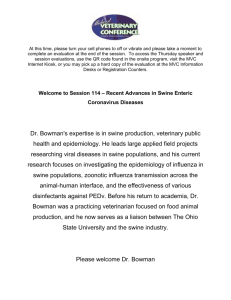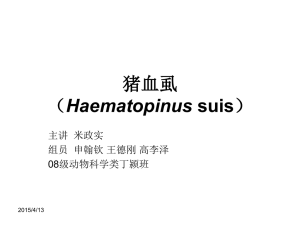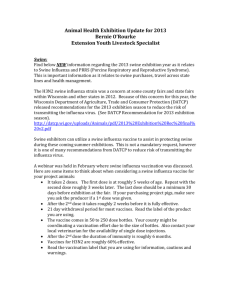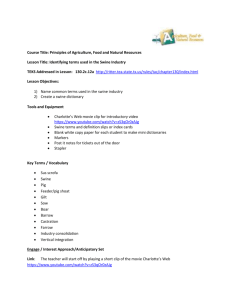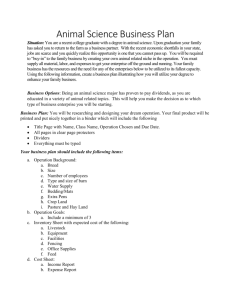Measures to Minimize Influenza Transmission at Swine Exhibitions 3
advertisement
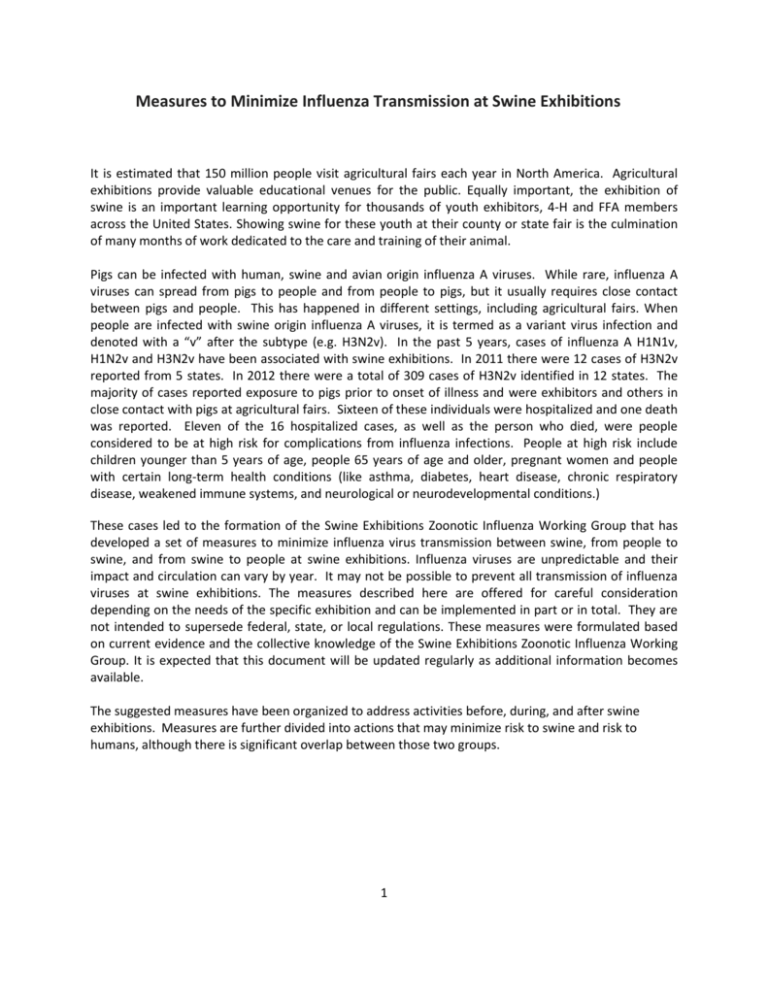
Measures to Minimize Influenza Transmission at Swine Exhibitions It is estimated that 150 million people visit agricultural fairs each year in North America. Agricultural exhibitions provide valuable educational venues for the public. Equally important, the exhibition of swine is an important learning opportunity for thousands of youth exhibitors, 4-H and FFA members across the United States. Showing swine for these youth at their county or state fair is the culmination of many months of work dedicated to the care and training of their animal. Pigs can be infected with human, swine and avian origin influenza A viruses. While rare, influenza A viruses can spread from pigs to people and from people to pigs, but it usually requires close contact between pigs and people. This has happened in different settings, including agricultural fairs. When people are infected with swine origin influenza A viruses, it is termed as a variant virus infection and denoted with a “v” after the subtype (e.g. H3N2v). In the past 5 years, cases of influenza A H1N1v, H1N2v and H3N2v have been associated with swine exhibitions. In 2011 there were 12 cases of H3N2v reported from 5 states. In 2012 there were a total of 309 cases of H3N2v identified in 12 states. The majority of cases reported exposure to pigs prior to onset of illness and were exhibitors and others in close contact with pigs at agricultural fairs. Sixteen of these individuals were hospitalized and one death was reported. Eleven of the 16 hospitalized cases, as well as the person who died, were people considered to be at high risk for complications from influenza infections. People at high risk include children younger than 5 years of age, people 65 years of age and older, pregnant women and people with certain long-term health conditions (like asthma, diabetes, heart disease, chronic respiratory disease, weakened immune systems, and neurological or neurodevelopmental conditions.) These cases led to the formation of the Swine Exhibitions Zoonotic Influenza Working Group that has developed a set of measures to minimize influenza virus transmission between swine, from people to swine, and from swine to people at swine exhibitions. Influenza viruses are unpredictable and their impact and circulation can vary by year. It may not be possible to prevent all transmission of influenza viruses at swine exhibitions. The measures described here are offered for careful consideration depending on the needs of the specific exhibition and can be implemented in part or in total. They are not intended to supersede federal, state, or local regulations. These measures were formulated based on current evidence and the collective knowledge of the Swine Exhibitions Zoonotic Influenza Working Group. It is expected that this document will be updated regularly as additional information becomes available. The suggested measures have been organized to address activities before, during, and after swine exhibitions. Measures are further divided into actions that may minimize risk to swine and risk to humans, although there is significant overlap between those two groups. 1 Measures to Consider BEFORE the Exhibition Each state should establish and maintain a communication network that includes the state animal health agency, state and local public health officials, exhibition organizers and managers, veterinarians, Cooperative Extension Service educators, vocational agriculture instructors and other stakeholders. State animal health officials in collaboration with state public health officials should determine a testing protocol for swine with clinical signs consistent with influenza and establish a method to distribute any test results to the appropriate animal health and public health agencies. Swine Measures For Exhibition Organizers: Limit the time pigs are congregated and co-mingled at an exhibition. Measures might include: o Shorten the total time pigs are on the exhibition grounds, ideally exhibition swine should be on the exhibition grounds no more than 72 hours. o Release pigs from the exhibition grounds as soon as possible following their respective show(s). o If offering both terminal pig and breeding swine shows, schedule the terminal show after the breeding swine show or schedule a break between shows. Use this break to clean and disinfect the facility. o Locate longer-term swine exhibits (i.e. Big Boars, birthing center animals, display exhibits of pigs) away from areas where the competition swine are housed. Establish a relationship with a veterinarian who will be present or on call for the duration of the exhibition. The veterinarian will be responsible for monitoring the animals for clinical signs, evaluating sick animals and taking additional steps as warranted to minimize the risk of influenzalike illness in the swine. Establish a protocol to immediately remove sick swine from the exhibition area. Maintain records of individual swine identification and source farms to enhance the speed and accuracy of an animal disease investigation associated with the exhibition. For Exhibitors: Consult a veterinarian to understand and implement applicable biosecurity and swine health practices at home. Become familiar with the clinical signs of influenza A in swine (fever, anorexia, lethargy, nasal discharge and cough). Seek veterinary assistance if a pig becomes sick. Understand the risks to both humans and animals of taking a sick pig to an exhibition. Ask the exhibition organizer about any specific actions that may be required if a pig becomes sick at the show. 2 Refrain from showing a pig and herd mates for at least seven (7) days after returning from an exhibition to reduce the risk of spreading influenza. Discuss the use of swine influenza vaccines with a veterinarian. Vaccines are available commercially and may be used prior to an exhibition. Swine vaccinated for influenza may be less likely to become ill, and if they become sick, they may be contagious for a shorter time. Human Measures It is recommended by the Centers for Disease Control and Prevention (CDC) that everyone 6 months of age or older be vaccinated annually against seasonal influenza. Seasonal influenza vaccine is usually distributed in late summer and early fall, and people should be vaccinated as soon as the vaccine becomes available. People at high risk for developing more severe complications from influenza include the following: children younger than 5 years old, people 65 years of age and older, pregnant women, and people with certain long-term health conditions (like asthma, diabetes, heart disease, chronic respiratory disease, weakened immune systems, and neurological or neurodevelopmental conditions). People in these high risk groups should limit their exposure to infected swine. For Exhibition Organizers Establish methods to rapidly communicate (i.e. email addresses and/or phone numbers from show entry information, social media channels, etc.) with exhibitors about procedural changes or incidents associated with the exhibition. Host non-animal-related activities (i.e. dances, pizza parties, etc.) in locations other than animal barns. For Exhibitors Understand that pigs and people can become infected from sick people. People with influenza-like illness should stay away from pigs until they are fever-free for at least 24 hours without the use of fever-reducing medication. Measures to Consider DURING the Exhibition Swine Measures For Exhibition Organizers Host a meeting with exhibitors and their family members prior to the start of the exhibition to do the following: 3 o o o o o Provide contact information for the designated exhibition veterinarian. Provide instructions on how to report animal illnesses and explain any specific actions that may be required if a pig becomes sick at the show. Provide contact information for a public health official who can answer public health questions and be available during the exhibition. Review exhibition regulations. Review and encourage disease control measures to be utilized during the exhibition, including the daily monitoring of the animals during the show, as well as for when the exhibitor returns home. For Exhibitors Observe swine daily for signs of influenza-like illness, which may include fever, lethargy, lack of appetite, nasal discharge or cough. Report any influenza-like illness to the designated exhibition veterinarian or the appropriate exhibition staff so the pig can be evaluated. The designated veterinarian should consider testing swine with signs of influenza-like illness. Results should be shared with animal health and public health officials. Swine deemed to be ill should be removed from the exhibition immediately. Use precautions when caring for sick pigs to minimize the opportunity for influenza transmission to other swine or people. Human Measures For Exhibition Organizers Provide easy access to hand washing stations. Post informational signage that includes the following messages: o No eating or drinking in the animal areas o Wash hands frequently o No pacifiers, sipping cups or strollers in the animal areas Discourage sleeping in the animal areas. If human or swine influenza-like-illness is associated with the exhibition, animal health and public health officials should be notified immediately. Public health officials should facilitate human testing for influenza viruses, including variant influenza viruses, investigate the source of illness, and attempt to identify additional human cases. If illness is detected in swine or humans, public health recommendations include: o People who have influenza-like illness should leave the exhibition immediately and seek medical care. They should advise their health care provider about their exposure to swine. o People at high risk for developing more severe complications from influenza, as listed above, should be discouraged from entering the swine areas. 4 Measures to Consider AFTER the Exhibition Swine Measures For Exhibit Organizers Clean and disinfect the swine exhibition areas. For Exhibitors Isolate and observe animals for illness after returning home and before allowing contact with other animals o The isolation/observation period for clinical signs of influenza should be no fewer than 7 days o Clean and disinfect equipment, clothing, shoes, and vehicles/trailers that were at the exhibition. o Consult a veterinarian if swine become ill. Human Measures Consult a health care provider and a public health official as soon as possible if exhibitors or family members develop influenza-like illness o Inform the health care provider of close contact with swine and/or exhibition attendance. o Ill people should avoid all contact with swine until they are fever-free for at least 24 hours without the use of fever-reducing medications. 5 Resources: Centers for Disease Control and Prevention: http://www.cdc.gov/flu/swineflu/ http://www.cdc.gov/flu/swineflu/h3n2v-cases.htm http://www.flu.gov/about_the_flu/h3n2v/index.html# http://www.flu.gov/symptoms-treatment/symptoms/index.html# http://www.cdc.gov/flu/swineflu/h3n2v-factsheet.htm http://www.cdc.gov/flu/pdf/swineflu/fair_exhibitor_factsheet.pdf National Pork Board Influenza Resources: http://www.pork.org/Resources/1389/influenza.aspx A Champion's Guide to Youth Swine Exhibition - National Pork Board (will be updated online and in print in 2013): http://www.pork.org/filelibrary/NPB%20A%20Champions%20Guide%20to%20Youth%20Swine%20Exhib ition.pdf National Pork Board Youth PQA (will be updated online and in print in 2013): http://www.pork.org/Certification/21/youthPqaPlus.aspx USDA Swine Influenza Virus (SIV) Surveillance Program Information: http://animalhealth/surveillance/siv/default.aspx 6 Working Group Members: Dr. Jeff Bender, Minnesota Center for Influenza Research and Surveillance (MCEIRS), University of Minnesota Dr. Jennifer House, National Association of State Public Health Veterinarians Dr. Jennifer Koeman, National Pork Board Dr. Carina Blackmore, National Association of State Public Health Veterinarians Dr. John Korslund, US Department of Agriculture Dr. Andrew Bowman, The Ohio State University Dr. Lisa Lauxman, USDA, NIFA, Youth & 4-H Dr. Tom Burkgren, American Association of Swine Veterinarians Dr. Bret Marsh, Co-chair, National Assembly of State Animal Health Officials Ms. Marla Calico, International Association of Fairs and Exhibitions Dr. David Marshall, National Assembly of State Animal Health Officials Dr. Dee Ellis, National Assembly of State Animal Health Officials Mr. Mike Paul, National Swine Registry Dr. David Pyburn, US Department of Agriculture Dr. Lyn Finelli, Centers for Disease Control and Prevention Dr. Joni Scheftel, Co-chair, National Association of State Public Health Veterinarians Dr. Tony Forshey, National Assembly of State Animal Health Officials Dr. Susan Trock, Centers for Disease Control and Prevention Dr. Ann Garvey, Council for State and Territorial Epidemiologists Dr. Timothy Uyeki, Centers for Disease Control and Prevention Dr. Chris Hahn, Council for State and Territorial Epidemiologists March 2013 7
